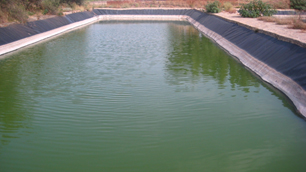6.4.1 Waste stabilisation ponds
Waste stabilisation ponds are natural or constructed ponds used for treating sewage or other wastewaters biologically by harnessing the power of sunlight and wind. They are ideal for tropical countries like Ethiopia. The sewage collected by the sewerage network in Addis Ababa goes to waste stabilisation ponds at Kality.
In a typical waste stabilisation pond system, effluent that has passed through a screen is sent through a series of ponds (Figure 6.9) with a total retention time of between 10 and 50 days. Bacteria in the ponds degrade the organic waste and work symbiotically with algae, which provide oxygen through photosynthesis. (Symbiotically means in a relationship where two types of living organism live together for their mutual benefit.) Oxygenation also occurs through the action of wind and by diffusion from the air. No mechanical equipment is used in the ponds, so operation and maintenance costs are very low. Land requirement is, however, high.

The major part of the biodegradation of the sewage takes place in the facultative ponds. Facultative ponds are 1–1.5 m deep, with a retention time of between 5 and 30 days. In these ponds the upper layers are aerobic and the lower layers of water are anaerobic. Solids settle to the bottom and are anaerobically digested, so sludge removal is rarely needed.
Maturation ponds are placed after facultative ponds for the purpose of pathogen reduction (Figure 6.10). These are usually 0.5–1.5 m deep with a retention time of between 15 and 20 days. These ponds serve to inactivate pathogenic bacteria and viruses through the action of UV radiation from sunlight and the greater algal activity in these shallow ponds, which raises the pH above 8.5. (pH is a measure of acidity and alkalinity. It has a scale from 0–14: pH 7 is neutral, less than 7 is acid and more than 7 is alkaline.) The long retention time in the maturation ponds also enhances the sedimentation of the eggs of intestinal parasitic worms.

If the wastewater has a very high level of pollutants, anaerobic ponds can be used ahead of the facultative ponds. Anaerobic ponds are 2–5 m deep and are nearly devoid of oxygen. Their retention time is one to seven days. Solids settle to the bottom, forming a sludge, and anaerobic digestion takes place, producing methane. Up to 60% of the organic material can be removed in this process (Tilley et al., 2014).
To prevent sewage from leaching away, and to preserve the effluent for reuse later, the ponds should have a liner. This can be made of clay, asphalt, compacted earth or any other impermeable material (material that does not let fluid pass through). To prevent run-off from entering the ponds and to prevent erosion, a protective raised earth barrier can be constructed around the ponds using the excavated material from their construction. Finally, a fence is needed to keep people and animals out (Tilley et al., 2014).
Any scum that builds up on the surface of the facultative and maturation ponds should be removed to allow sunlight to reach all the algae and also to increase surface aeration. Large plants that are present in the water should be removed.
Treated sewage can be reused in crop irrigation if safe limits of faecal bacteria and intestinal parasite eggs are achieved in the treatment process. At the same time as treating wastewater, pond systems have been used to increase protein production through the rearing of fish (such as Tilapia) and ducks in maturation ponds.
6.4 Wastewater treatment options
